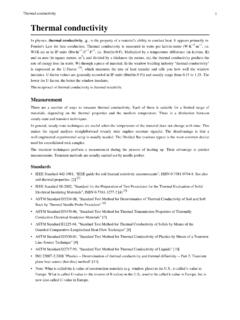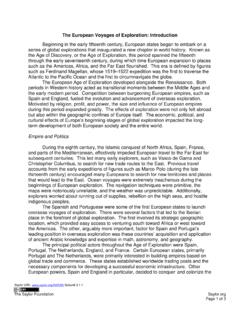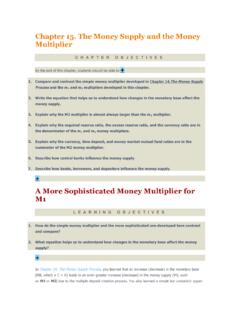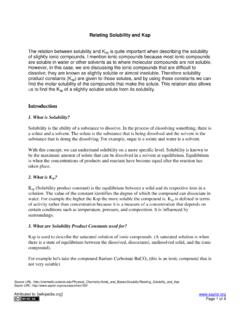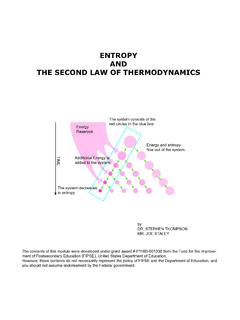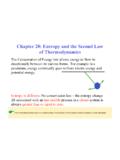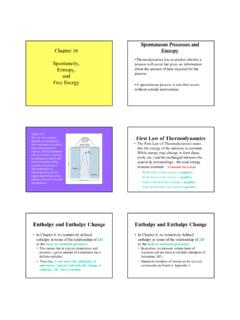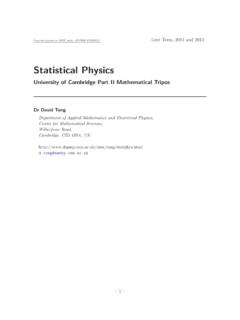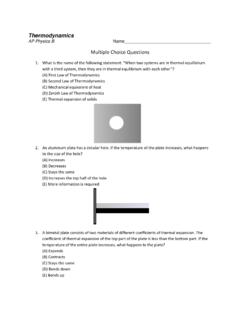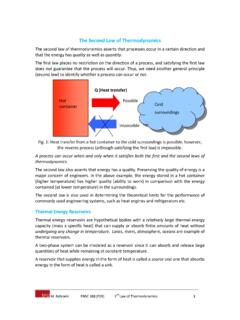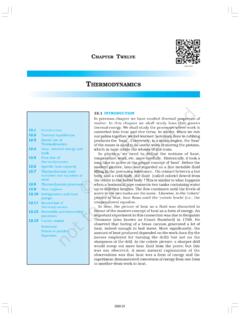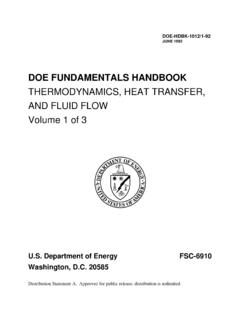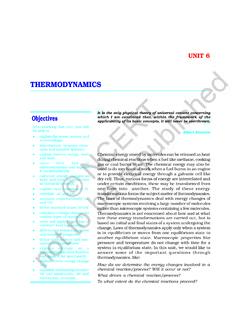Transcription of Chapter 4 The First Law of Thermodynamics
1 Chapter 4 -1 Chapter 4 The First Law of ThermodynamicsThe First law of Thermodynamics is an expression of the conservation ofenergy principle. Energy can cross the boundaries of a closed system in theform of heat or work. Energy transfer across a system boundary due solelyto the temperature difference between a system and its surroundings iscalled heat. Work energy can be thought of as the energy expended to lift a weight. Closed System First Law A closed system moving relative to a reference plane is shown belowwhere z is the elevation of the center of mass above the reference plane andGVis the velocity of the center of the closed system shown above, the conservation of energy principleor the First law of Thermodynamics is expressed as Total energyentering the systemTotal energyleaving the systemThe change in total energy of the systemFHGIKJ FHGIKJ=FHGIKJorEEEinoutsystem = CMHeatWorkzClosedSystemReference Plane, z = 0 GVChapter 4 -2 According to classical Thermodynamics , we consider the energy added to benet heat transfer to the closed system and the energy leaving the closedsystem to be net work done by the closed system.
2 So QW Enetnetsystem = Normally the stored energy, or total energy, of a system is expressed as the sum of three separate energies. The total energy of the system, Esystem, isgiven as EInternal energyKinetic energyPotential energyEU KE PE= + + = + + Recall that U is the sum of the energy contained within the molecules of thesystem other than the kinetic and potential energies of the system as awhole and is called the internal energy. The internal energy U is dependenton the state of the system and the mass of the a system moving relative to a reference plane, the kinetic energy KEand the potential energy PE are given by2002 VVzzmVKEmV dVPEmg dzmgz====== GGGGGThe change in stored energy for the system is EUKEPE=+ + Chapter 4 -3 Now the conservation of energy principle, or the First law ofthermodynamics for closed systems, is written asQW UKEPE netnet =+ + If the system does not move with a velocity and has no change in elevation,the conservation of energy equation reduces toQW Unetnet = We will find that this is the most commonly used form of the fist System First Law for a CycleSince a thermodynamic cycle is composed of processes that cause theworking fluid to undergo a series of state changes through a series ofprocesses such that the final and initial states are identical.
3 The change ininternal energy of the working fluid is zero for whole numbers of First law for a closed system operating in a thermodynamic cyclebecomesQW UQWnetnetcyclenetnet == 0 Chapter 4 -4 Example 4-1 Complete the table given below for a closed system under going a Qnet kJ Wnet kJ U2 U1 kJ 1-2 +5 -5 2-3 +20 +10 3-1 -5 Cycle (Answer to above problem) Row 1: +10, Row 2: +10, Row 3: -10, -5 Row 4: +15, +15, 0 Example 4-2 Find the required heat transfer to the water in Example 3-5. Review the solution procedure of Example 3-5 and then apply the First lawto the of Energy:,14,1414inoutnetnetEEEQW U = = Chapter 4 -5In Example 3-5 we found that WkJnet,.1412=The heat transfer is obtained from the First law as,14,1414netnetQW U=+ where UUUmuu144141= = ()At state 1, T1 = 100 C, v1 = m3/kg and vf < v1 < vg at T1. The qualityat state 1 is xvvvxv=+ === uu xukJkgffg11418 940 499 2087 61460 26=+=+=.
4 (.)( .).Because state 4 is a saturated vapor state and v4 = m3/kg, interpolatingin either the saturation pressure table or saturation temperature table at v4 =vg givesChapter 4 -6ukJkg42531 48=.So1441()(1)( ) = = =The heat transfer is QW UkJkJkJnetnet,,..141414121071221072 42=+=+= Heat in the amount of kJ is added to the : Specific Heats and Changes in Internal Energy andEnthalpy for Ideal GasesBefore the First law of Thermodynamics can be applied to systems, let sreview the ways to calculate the change in internal energy and enthalpy ofthe substance enclosed by the system boundary. For real substances likewater, the property tables are used to find the internal energy and enthalpychange. For ideal gases we learned in Chapter 2 that the internal energy andenthalpy are found by knowing the specific heats. Chapter 4 -7videal gasideal gas and VPPuduh dhCCTdTT dT ==== The change in internal energy and enthalpy of ideal gases can be expressedas uu u CTdTC T Thh h CTdTC T TVVavePPave= == = == zz211221211221()()()(),,where CV,ave and CP,ave are average or constant values of the specific heatsover the temperature range.
5 We will drop the ave subscript the above figure an ideal gas undergoes three different process betweenthe same two 1-2a: Constant volumeProcess 1-2b: P = a + bV, a linear relationshipProcess 1-2c: Constant pressureThese ideal gas processes have the same change in internal energy andenthalpy because the processes occur between the same temperature DIAGRAM FOR SEVERAL PROCESSES FOR ANIDEAL 4 -8 uuuCTdThhhCTdTabc Vabc P======zz()()1212To find u and h we often use average, or constant, values of the specificheats. Some ways to determine these values are as follows: 1. The best average value (the one that gives the exact results)See Table A-2(c) for variable specific ,,()()= = zz12211221 and 2. Good average values areCCT CTCCT CTvaveVVPavePP,,()()()()=+=+212122 and andCCTC CTTTTv aveVaveP avePaveave,,()()===+ and where2123. Sometimes adequate (and most often used) values are the ones evaluatedat 300 K and are given in Table A-2(a).
6 CCKC CKvaveVPaveP,,()()==300300 and Chapter 4 -9 Let's take a second look at the definition of u and h for ideal gases. Justconsider the enthalpy for now. hh h CTdTP= =z2112()Let's perform the integral relative to a reference state where h = href at T = Tref. hh hCTdTCTdTPTTPTT refref= = + zz2112()()or h h hC TdTC TdThhhhPTTPTT refrefrefref= = = zz212121()()()()At any temperature, we can calculate the enthalpy relative to the referencestate ashhCTdTorhhCTdTrefPTTrefPTTrefref = =+ zz()()This result is the basis of Table A-17 for air and Tables A-18 through A-25for other gases. A similar result is found for the change in internal energy. Chapter 4 -10 The Systematic Thermodynamics Solution ProcedureWhen we apply a methodical solution procedure, Thermodynamics problemsare relatively easy to solve. Each Thermodynamics problem is approachedthe same way as shown in the following, which is a modification of theprocedure given in the text: Thermodynamics Solution Method1.
7 Sketch the system and show energy interactions across Determine the property relation. Is the working substancean ideal gas or a real substance? Begin to set up and fill in aproperty Determine the process and sketch the process to fill in the property Apply conservation of mass and conservation of Bring in other information from the problem statement,called physical constraints, such as the volume doubles orthe pressure is halved during the Develop enough equations for the unknowns and solve. Chapter 4 -11T1=27 CExample 4-3A tank contains nitrogen at 27 C. The temperature rises to 127 C by heattransfer to the system. Find the heat transfer and the ratio of the finalpressure to the initial pressure. System: Nitrogen in the tank. Property Relation: Nitrogen is an ideal gas. The ideal gas propertyrelations apply. Let s assume constant specific heats.(You are encouraged to rework this problem usingvariable specific heat data.)
8 Process: Tanks are rigid vessels; therefore, the process is constant of Mass:mm21=Using the combined ideal gas equation of state,PVTPVT222111=Since R is the particular gas constant, and the process is constant volume, NITROGENGASS ystemboundary2T2=127 C1P-V diagram for a constantvolume processPVChapter 4 -12 VVPPTTKK212121127 27327 2731 333===++=()().Conservation of Energy:The First law closed system isinoutnetnetEEEQW U = = For nitrogen undergoing a constant volume process (dV = 0), the net workis (Wother = 0)WWPdVnetb,,12121200=+ = =zUsing the ideal gas relations with Wnet = 0, the First law becomes (constantspecific heats)QUmCdTmCTTnetVV = == z01221 ()The heat transfer per unit mass isChapter 4 -13qQmCT TkJkg KKkJkgnetnetV== = =()..210743127 2774 3bgExample 4-4 Air is expanded isothermally at 100 C from MPa to MPa. Find theratio of the final to the initial volume, the heat transfer, and work. System: Air contained in a piston-cylinder device, a closed systemProcess: Constant temperature Property Relation: Assume air is an ideal gas and use the ideal gasproperty relations with constant specific diagram for T= constantPV21 AIR WBT= 4 -14 PVmRTuCT TV== ()21 Conservation of Energy:EEEQW Uinoutnetnet = = The system mass is constant but is not given and cannot be calculated;therefore, let s find the work and heat transfer per unit Calculation:WWWnetnetotherb,,,121212=+bg 22,121121=lnbmRTWP dVdVVVmRTV== Conservation of Mass: For an ideal gas in a closed system (mass =constant), we havemmPVRTPVRT12111222==Since the R's cancel and T2 = T1 Chapter 4 -15 VVPPMPaMPa211204014===.
9 Then the work expression per unit mass becomes wWmRTVVbb,,ln121221==FHGIKJwkJkgKKkJkgb, .() 287100 2734148 4= FHGIKJ+=bgThe net work per unit mass iswwkJkgnetb,,.121201484=+ =Now to continue with the conservation of energy to find the heat T2 = T1 = constant, UmumCTTV1212210== =()So the heat transfer per unit mass is Chapter 4 -16qQmqw uqwkJkgnetnetnetnetnetnet= ==== 0148 heat transferred to the air during an isothermal expansion processequals the work Using Variable Specific HeatsReview the solutions in Chapter 4 to the ideal gas examples where thevariable specific heat data are used to determine the changes in internalenergy and enthalpy. Extra Problem for You to Try:An ideal gas, contained in a piston-cylinder device, undergoes a polytropicprocess in which the polytropic exponent n is equal to k, the ratio of specificheats. Show that this process is adiabatic. When we get to Chapter 6 youwill find that this is an important ideal gas 4 -17 Example 4-5 Incompressible LiquidA two-liter bottle of your favorite beverage has just been removed from thetrunk of your car.
10 The temperature of the beverage is 35 C, and you alwaysdrink your beverage at 10 C. a. How much heat energy must be removed from your two liters ofbeverage?b. You are having a party and need to cool 10 of these two-liter bottles inone-half hour. What rate of heat removal, in kW, is required?Assuming that your refrigerator can accomplish this and that electricitycosts cents per kW-hr, how much will it cost to cool these 10bottles?System: The liquid in the constant volume, closed system containerProperty Relation: Incompressible liquid relations, let s assume that thebeverage is mostly water and takes on the propertiesof liquid water. The specific volume is m3/kg,C = kJ/kg : Constant volumeVV21=QoutThe heatremovedSystemboundaryMybeverageChapt er 4 -18 Conservation of Mass:mmmmVvLmkgmLkg213320 00110002====FHGIKJ=.Conservation of Energy:The First law closed system isEEEinout = Since the container is constant volume and there is no other work done onthe container during the cooling process, we haveWWWnetnetotherb=+=bg0 The only energy crossing the boundary is the heat transfer leaving thecontainer.


